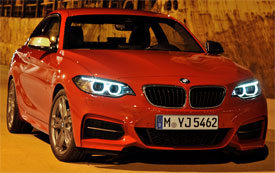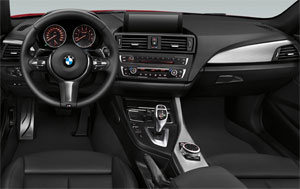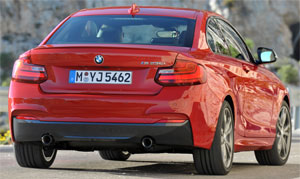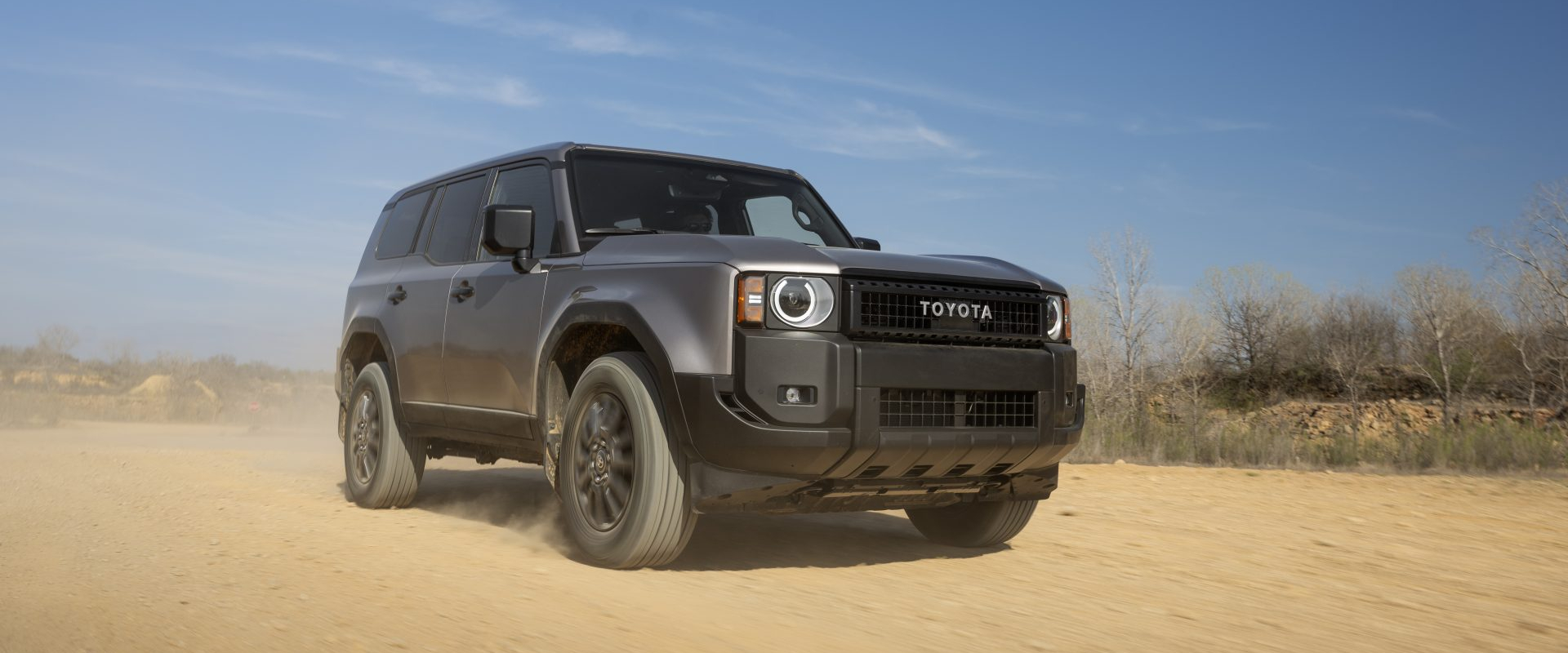2014 BMW 2 Series
While large BMW’s undoubtedly have a lot to offer, it’s always been the small ones that we’ve like best. Well one of our favorites, the 1 Series coupe is no more. But take heart, that doesn’t mean it’s gone. It’s just wearing a new name, and with it, a whole new attitude!
By now you should be up to speed on BMW’s naming strategy of even number series for coupes and odds for sedans. Well, the latest to fall in line is the 2014 BMW 2 Series, of which this M235i is the current top rung.
But don’t let the “M” name fool you, it’s not a full on M car, but an M “Performance” model. Sort of a tweener if you will, between garden-variety Bimmers and full on M monsters. Basically, more performance, without any compromise in comfort. It makes for a fun factor that’s hard to top in value.
While the 2 replaces the 1 Series Coupe in the lineup, it’s more than a name change. The 2 has gotten bigger, though thankfully not by too much. Every dimension is increased; with overall length up most; 2.8-inches to 174.5. To further distinguish itself, styling is a bit more dramatic; though still fairly conservative; with just enough Teutonic cool to attract more ironic hipsters and young professionals.
 Power in our M235i is from a familiar 3.0-liter BMW turbo I6. We’ve lost count of how many BMW’s we’ve driven with this engine and we still love it. It has gotten some M Performance specific tweaks here that raise horsepower to 320 and torque to 330 lb-ft. The base 228i comes with a still competent 240-horsepower 2.0-liter turbo-4.
Power in our M235i is from a familiar 3.0-liter BMW turbo I6. We’ve lost count of how many BMW’s we’ve driven with this engine and we still love it. It has gotten some M Performance specific tweaks here that raise horsepower to 320 and torque to 330 lb-ft. The base 228i comes with a still competent 240-horsepower 2.0-liter turbo-4.
An 8-speed automatic transmission with paddle shifters, as in our test car, is standard; and we found nothing to complain about as shifts are quick in auto mode and response very good when in manual mode. You can still opt for a 6-speed manual, as well.
But, enough sitting still. It’s off to our test track, where the M235i promptly moved off the line with what feels like the perfect amount of power, launching to 60 in an entertaining 5.2-seconds. There’s very little drop off in power as the trans quickly works its way through the gears and to the end of the ¼-mile in 14.0-seconds at 102 miles-per-hour.
A mostly aluminum structure for a typical BMW 50/50 weight balance allows you to push through the corners with minimal loss of speed, and great grip, as well. Suspension design is a double-pivot spring strut arrangement up front and a 5-link in the rear. Adaptive M suspension and electronically controlled shock absorbers are standard on the M235i, with an optional mechanical limited slip rear differential.
Steering feels great both at the wheel and through the chassis. The M235i has the most steering feedback of any BMW we’ve driven in a long time. Brakes, however, not so much. Feedback here is middle of the road with a softish pedal. Still, stops were quick; 115 feet from 60 with excellent stability.
 Inside we found a very familiar BMW layout with high quality materials and well done controls throughout the driver-focused space. Yes, that comment even includes iDrive. Front sport seats provide good comfort and support with moderate bolstering. Rear seats however, much less so with merely a suggestion of legroom. Trunk space is actually fairly good for a sporting coupe at 13.8 cubic-ft.; aided by folding seatbacks for more cartage room when needed.
Inside we found a very familiar BMW layout with high quality materials and well done controls throughout the driver-focused space. Yes, that comment even includes iDrive. Front sport seats provide good comfort and support with moderate bolstering. Rear seats however, much less so with merely a suggestion of legroom. Trunk space is actually fairly good for a sporting coupe at 13.8 cubic-ft.; aided by folding seatbacks for more cartage room when needed.
A Driving Experience Control is standard with settings for Comfort, Sport, Sport +, and Eco Pro. Playing with the different modes alters the driving experience noticeably, but Sport or Sport + is where it’s at for us.
But, if this is your first BMW, you might find the ride in those settings quite stiff. Comfort mode helps somewhat, or you can just do your best to avoid broken pavement. No matter which mode you’re in, the exhaust note is great, growling without being obnoxious.
For a small car, it has an overall very solid, almost heavy feel. Not in a bad way; it just feels more substantial and competent than light and toss able.
Government Fuel Economy Ratings for our automatic come in at 22-City, 32-Highway, and 25-Combined. We averaged a fine 25.2 miles-per-gallon in a mildly executed loop of driving. The Energy Impact Score is 13.2-barrels of oil used and 5.8-tons of CO2 emitted annually.
 At the risk of going all fanboy, we’ll say that the M235i is just about a perfect package. But perfection never comes cheap with a base price of $44,025. The base, and still very competent, 228i is much more accessible at $33,025.
At the risk of going all fanboy, we’ll say that the M235i is just about a perfect package. But perfection never comes cheap with a base price of $44,025. The base, and still very competent, 228i is much more accessible at $33,025.
The 2014 BMW M235i is truly one excellent car. No other premium subcompact coupe comes close. It drives like passionate BMW fans think every BMW should. So, if you’re in the position to leave the family behind, it’s an incredibly fun ride. Proof that sometimes numbers can work in your favor.
Specifications
- Engine: 3.0-liter
- Horsepower: 320
- Torque: 330 lb-ft.
- 0-60 mph: 5.2 seconds
- 1/4 mile: 14.0 seconds @ 102 mph
- EPA: 22 mpg city/ 32 mpg highway
- Energy Impact: 13.2 barrels of oil/yr
- CO2 Emissions: 5.8 tons/yr
2024 Toyota Land Cruiser
Toyota’s Go Anywhere Globetrotter Returns To U.S.
Every once in a while, we all need a reset. A time to get back to basics and prioritize the things that really matter. Well, for the Toyota Land Cruiser that time is now. So, let’s find out if that means bigger and better things for Toyota’s iconic off-roader.
The Toyota Land Cruiser’s status among the global off-road community is legendary, and it’s hard to imagine there’s any corner of the earth where a Land Cruiser hasn’t kicked up a little dust or mud. Well, 2024 sees the return of the Land Cruiser to the U.S. market after a 3-year hiatus, getting a major reset for the journey.
The reset comes mostly by no longer being based on the large three-row “300-series” chassis, but a new version of the smaller “200-series,” now known as the J250. As with the latest Tacoma, it uses the Tundra pickup’s full-size steel frame.
While the main Land Cruiser model, which goes by simply Land Cruiser, is packed full of luxury and convenience features, there is also a stripped-down model known as the 1958, honoring the first year the Land Cruiser made landfall here in North America. And it is that 1958 we have here, and we were glad to see it, as it also celebrates the original’s back-to-basics approach as a blank canvas for you to personalize as you tackle more and more adventures.
Not that it’s fully stripped down, as 8-inch touchscreen infotainment, a 7-inch full-color multi-information display, and automatic climate control are still standard. Plus, some seriously durable materials, and great heated cloth front seats that throw off some get serious 1990s Tacoma vibes.
But outside, there’s a definite lack of flashy trim and basic looking 18-inch wheels with Yokohama Geolander all-season tires; plus, big chunky bumpers and tilt-up back glass, which is a rarity that we appreciate. Though there is a little too much plastic in places that are sure to see some abuse if you do any significant off-roading.
It even feels a little rough around the edges, but for us it just adds to the rugged old-school utility vibe in a good way.
We did just that, both here in the Mid-Atlantic as well as in the California desert; and while there are some tech-forward driving aids, the actual hardware is in most cases plenty to get things done. That includes standard full-time dual-range four-wheel-drive, locking center and rear diffs, and 8.7-inches of ground clearance. A front stabilizer bar disconnect is also available to allow for increased articulation.
Who needs a V6 or even a V8 when you’ve got Toyota’s i-FORCE MAX setup at your disposal with 326 horsepower and 465 lb-ft of torque coming from a 2.4-liter turbo-four with an electric motor sandwiched between the engine and its eight-speed automatic transmission. Low speed torque delivery is impressive. It even feels a little rough around the edges, which may be a turn off to some, but for us it just adds to the rugged old-school utility vibe in a good way.
And it certainly feels quicker than an off roader needs to be, with an instant torque dump as soon as we eased on the throttle at our Mason Dixon test track; helping us get to 60 in 8.1 seconds and through the quarter-mile in 16.3 seconds at 86 mph. Considering the Land Cruiser’s terrain conquering mission, it behaved quite well in our handling course; it was plenty responsive to inputs, with less body roll than we expected and plenty of grip from the tires. The steering was light and quick but as expected didn’t provide much feel. Other than significant nosedive, braking performance was exceptional. Only 107-feet to panic stop us from 60 mph.
With the shift to the smaller size, there’s no more third row available, and cargo capacity now comes in at 46.2 cubic-feet with a max of a still healthy 82.1. Now, the best part of the Land Cruiser’s return is the entry price of $57,445. That’s about 30-grand less than what the last Land Cruiser went for back in 2021.
Whether it’s over the top fashion trends, mullets, or zombies; just when you think they’re dead, they come roaring back to life. Of course, we’re much happier to see the resurrection of this 2024 Toyota Land Cruiser than any of those things. Toyota is one brand that still recognizes the value of full-framed rugged rigs and has also acknowledged that sometimes less really is more. The Godfather of Toyota off-roading is back and better than ever.







